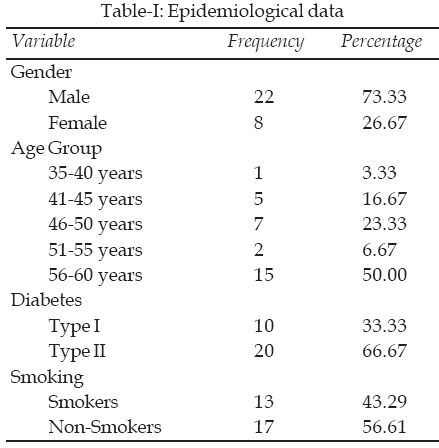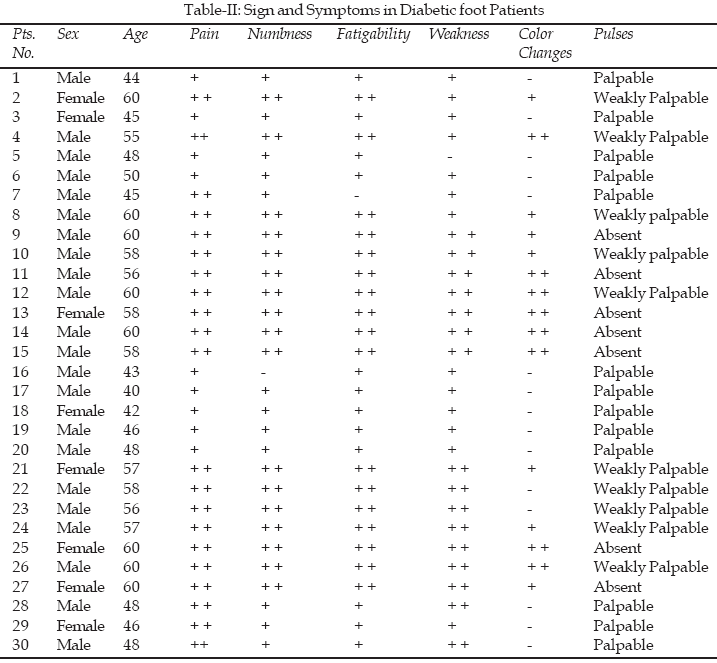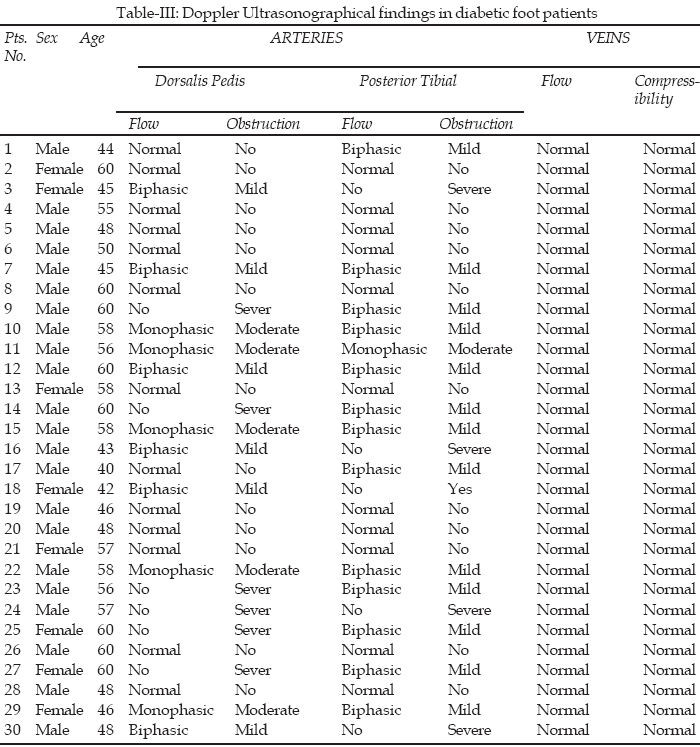|
|
||||
|
Published by : PROFESSIONAL MEDICAL PUBLICATIONS |
||||
|
ISSN 1681-715X |
||||
|
||||
|
- |
||||
|
ORIGINAL ARTICLE |
||||
|
- |
||||
|
Volume 25 |
April - June 2009 (Part-II) |
Number 3 |
||
|
|
||||
|
|
||||
|
|
||||
|
Published by : PROFESSIONAL MEDICAL PUBLICATIONS |
||||
|
ISSN 1681-715X |
||||
|
||||
|
- |
||||
|
ORIGINAL ARTICLE |
||||
|
- |
||||
|
Volume 25 |
April - June 2009 (Part-II) |
Number 3 |
||
|
|
||||
|
|
||||
Vasculopathy in patients with diabetic
foot using doppler ultrasound
Abdul Rahman1, Mahmood Moizuddin2,
Masood Ahmad3, Manzar Salim4
ABSTRACT
Objective: To determine the extent of vasculopathy in patients with diabetic foot using Doppler ultrasound scanning.
Methodology: This descriptive study was carried out in Surgical Unit III, Civil Hospital, Karachi from January 2004 to December 2005. All patients having diabetic foot complications including abscess formation, cellulitis, ulceration and gangrene were included in the study after taking informed consent. Peripheral pulses like posterior tibial, dorsalis pedis, and popliteal arteries were checked. The presence of vasculopathy was checked with Doppler scanning of dorsalis pedis artery, posterior tibial artery, popliteal artery and veins. The data was collected on a proforma that was specially designed for this study.
Results: Out of the total 30 patients included in this study, vasculopathy was detected in 19 (63.33%) patients. The pulse was clinically weak in 10 (33.33%) and absent in 7 (23.33%) patients, while the Doppler scan revealed that in 17 (56.66%) cases the dorsalis pedis artery and in 19 (63.33%) the posterior tibial artery was involved. These findings were asymmetrical i.e. they were mostly found in the affected limb, with a male preponderance.
Conclusion: This study shows that the vasculopathy is strong independent risk factor in the development of diabetic foot lesions. The usual symptoms and signs of lower limb ischemia may not be present and indeed may be misleading in diabetic foot disease.
KEY WORDS: Diabetic foot, Vasculopathy, Doppler scan.
Pak J Med Sci April - June 2009 (Part-II) Vol. 25 No. 3 428-433
How to cite this article:
Rahman A, Moizuddin M, Ahmad M, Salim M. Vasculopathy in patients with diabetic foot using doppler ultrasound. Pak J Med Sci 2009;25(3):428-433.
1. Dr. Abdul Rahman,
2. Dr. Mahmood Moizuddin,
3. Dr. Masood Ahmad,
1-3: Medical Officer,
4. Prof. Manzar Salim
1-4: Surgical Unit III,
Civil Hospital,
Karachi - Pakistan.
Correspondence
Dr. Abdul Rahman
Medical Officer,
Surgical Unit III,
Civil Hospital,
Karachi, Pakistan.
* Received for Publication: January 29, 2009
* Revision Received: April 6, 2009
* Revision Accepted: April 15, 2009
INTRODUCTION
Diabetes mellitus with its associated complications is a major cause of morbidity and mortality worldwide.
1 The development and progression of chronic complications of diabetes are closely related to glycaemic control.2 Diabetic foot is one of the most frequent reasons for hospitalization in a surgical ward, its complications include abscess formation, cellulitis, ulceration & gangrene.3 The classical triopathy of diabetic foot syndrome is angiopathy, neuropathy and infection, either alone or in combination.4 In Pakistan in the absence of any Diabetic Foot Clinics in tertiary care hospitals, patients with diabetic foot ulcers visiting healthcare facilities are shunted from medical to surgical & orthopaedic wards with no body willing to own them. Hence, they continue to suffer from this "shunting phenomenon".5Despite advances in our understanding and treatment of diabetes mellitus, diabetic foot disease remains a terrifying problem. Diabetes is recognized as the most common cause of non-traumatic lower limb amputation in the western world, with individuals over 20 times more likely to undergo an amputation compared to the rest of the population.
6Also a study from Civil Hospital, Karachi showed that the most common cause of lower limb amputation is complication of diabetes mellitus.7 There is growing evidence that the vascular contribution to diabetic foot disease is greater than was previously realised.8 This is important because, unlike peripheral neuropathy, Peripheral Arterial Occlusive Disease (PAOD) due to atherosclerosis, is generally far more amenable to therapeutic intervention. PAOD, as indicated by a low TcPO2 on the dorsum of the foot, has been demonstrated to be a greater risk factor than neuropathy in both foot ulceration and lower limb amputation in patients with diabetes.9 Diabetes is associated with macrovascular and microvascular disease. The term peripheral vascular disease may be more appropriate when referring to lower limb tissue perfusion in diabetes, as this encompasses the influence of both microvascular dysfunction and PAOD.For evaluation of the vascular status in these patients different invasive and non-invasive methods are available like arteriography, doppler and duplex scanning.
10 Doppler scanning is widely preferred as it is simple, versatile and handy. The accurate diagnosis of the underlying cause is the first step towards a successful treatment plan. This study was planned to determine the extent of vasculopathy in patients with diabetic foot using Doppler scanning.METHODOLOGY
All patients who were admitted in Surgical Unit III of Civil Hospital, Karachi for the treatment of Diabetic Foot complications from January 2004 to December 2005 were included in this descriptive study. Informed consent was obtained in all cases. Detailed history was recorded with emphasis on points like family history of diabetes, history of smoking, symptoms of peripheral vascular disease (rest pain), history of any foot trauma, ill fitting shoes and in growing toe nails. Clinical examination included complete inspection of the feet and legs noting the shape, any deformity, site and extent of foot lesions and evidence of gangrene. Peripheral pulses like posterior tibial, dorsalis pedis, and popliteal arteries were checked.
The presence of vasculopathy was checked with Doppler scanning of dorsalis pedis artery, posterior tibial artery, popliteal artery and veins. If Doppler ultrasonography was triphasic, it was graded as normal, biphasic as mild, monophasic as moderate and no sound was heard then severe grade of vasculopathy.
11The data was collected on a proforma that was specially designed for this study. Since this is a descriptive study, therefore no inferential tests were applied. SPSS version 10.0 was used for descriptive data analysis.
Results
Over a period of two year, thirty diabetic patients with foot complications were included in the study. Foot complications were abscess, cellulitis, ulcer and gangrene. Demographic profile of patients is shown in Table-I.

The symptomatology of patients (Table-II) revealed that 9 (30%) patients had mild while 21 (70%) had severe pain. Twelve (40%) patients reported mild numbness and fatigability, and 17 (56.66%) severe. Thirteen (43.33%) patients complained of mild weakness and 16 (53.33%) severe weakness. (Table-II)

The data shows clinical vasculopathy in 17 (56.66%) cases (Table-II); the pulse being weakly palpable in 10 (33.33%) and absent in 7 (23.33%) patients. However, Doppler scanning data (Table-III) revealed that in 17 (56.67%) cases the dorsalis pedis and in 19 (63.33%) the posterior tibial arteries were involved. These findings were asymmetrical i.e. they were mostly found in the affected limb only and there was male preponderance with a history of cigarette smoking.

The results of the vasculopathy given in Table-III and Table-IV show that flow in the dorsalis pedis artery was normal in 13 (43.33%) cases with mild obstruction in 6 (20%), moderate in 5 (16.67%) and severe obstruction in 6 (20%) patients. The flow in the posterior tibial artery on the other hand was normal in 11 (36.67%) cases with mild obstruction in 13 (43.33%), moderate in one (3.33%) and severe obstruction in 5 (16.67%) patients. No obstruction in the venous flow was noted.

Discussion
The subjective study of arterial assessment i.e. feeling the pulses is not reliable.
12 In this study, clinically, the pulses were weakly palpable in 33.33% and absent in 23.33% patients. However Doppler ultrasonography, which assesses the blood flow revealed that in 56.67% cases the dorsalis pedis artery and in 63.33% the posterior tibial arteries were involved. These findings were asymmetrical i.e. they were mostly found in the affected limbs with male preponderance. The latter fact is probably due to the reason that in our society males mostly work outdoors and they work bare foot; thus are more prone to trauma. Besides, a lot of males smoke cigarette which impedes blood flow by increasing vasospasm, blood viscosity and hypercoagulability, thus predisposing to ischemic foot ulceration. A study by Jirkovska A et al.13 was conducted about the comparison of a simple standardized noninvasive examination of neuropathy and angiopathy with routine diagnostic practice (Doppler ultrasound) in community diabetes clinics for the identification of patients at risk of foot ulceration. It showed that patients with angiopathy at risk of developing diabetic foot ulcers (ABI d"0.8) had been diagnosed, in diabetes clinics, to have peripheral arterial disease in 50% (they reported claudications in 41%, had femoral artery bruits detected in 29% and nonpalpable peripheral pulsations in 12%). These findings highlight the importance of using standardized simple noninvasive testing methods to increase the accuracy of identifying patients at risk for the diabetic foot at the community level.Richards-George P. in his paper about vasculopathy on Jamaican diabetic clinic attendees showed that Doppler measurements of ankle/brachial pressure index (A/BI) revealed that 23% of the diabetics had peripheral occlusive arterial disease (POAD) which was mostly asymptomatic.
14 This underscores the need for regular Doppler A/BI testing in order to improve the recognition, and treatment of POAD.Few studies have examined arterial compliance in Type-I diabetes patients. Berry et al
15 used Doppler flow volume to show 29% reduction in systemic arterial compliance. Yden-Ahlgren et al16 also showed increased arterial stiffness amongst women with Type-I diabetes. Duperz et al17 studied 31 diabetic patients on insulin therapy and found an inverse co-relation between small artery compliance and the duration of diabetes. This study emphasizes the need for the prevention or reversal of peripheral vascular disease in diabetic foot patients.Ageing is associated with both neuropathic ulcers and peripheral vascular diseases among individual with diabetes.
18 Majority (56.67%) of our patients with diabetic foot were above 50 years of age. The duration of diabetes was more than 12 years in most of the patients. This showed an increase in the incidence of the diabetic foot as the duration of diabetes increases.A study from Baqai Institute of Diabetes and Endocrinology (BIDE) showed that lack of awareness, poor glycaemic control and duration of diabetes were the main factors causing diabetic foot problems.
19 This study also confirmed that microvascular complications should be screened in patients with diabetic foot ulcers. Foot care education would be the most important way of dealing with this major problem.19 Another study from the same institute about estimated direct cost of management increased from 2700 ± 250 rupees (£21 ± 2) for a University of Texas Diabetic Wound Classification (UT) grade 1, stage B ulcer to 37 415 ± 24 125 rupees (£288 ± 186) for UT grade 2, stage D and 49 058 ± 30 144 rupees (£378 ± 232) for UT grade 3, stage D ulcers, respectively. The mean direct cost of major amputation (transtibial or transfemoral) was 46 182 ± 30 742 (£356 ± 237) whilst the cost of a minor amputation was 50 494 ± 30 488 rupees (£389 ± 235).20Foot complications in patients with diabetes can be prevented and managed with an integrated, multidisciplinary approach. It requires the involvement of a chain extending from the chiropodist and general practioner to the general surgeon, vascular surgeon and the rehabilitation specialists. Accurate diagnosis of the underlying cause is the first step towards a successful treatment plan. The most important intervention to prevent diabetic foot complications is early recognition of high risk patients and their referral to the multidisciplinary team. Prompt treatment decreases the risk of the fatal outcome i.e. amputation.
Conclusion
This study shows that the vasculopathy is strong risk factor in the development of diabetic foot lesions. The usual symptoms and signs of lower limb ischemia may not be present and indeed may be misleading in diabetic foot disease. The presence of diabetic microvascular disease imparts an even greater importance on the early detection and treatment of significant macrovascular disease. Laboratory vascular assessments are an important aid in detecting lower limb vascular disease. It is important to identify and quantify the role of vasculopathy, in order to plan effective strategies for preventing or delaying foot complications, especially its fatal outcome i.e. amputation.
REFERENCES
1. Amini M, Parvaresh E. Prevalence of macro- and microvascular complications among patients with type 2 diabetes in Iran: a systematic review. Diabetes Res Clin Pract 2009;83(1):18-25.
2. Shera AS, Jawad F, Maqsood A, Jamal S, Azfar M, Ahmed U. Prevalence of chronic complications and associated factors in type 2 diabetes. J Pak Med Assoc 2004;54(2):54-9.
3. Muhammed Y, Rafiq K, Goraya AR. Treatment option of diabetic foot experience at Mayo Hospital, Lahore. Ann King Edward Med Coll 2000;6:388-90.
4. Aslam M, Abbas Q. Comparative study of Ankle Brachial Index, DSA and Doppler Flowmetery in evaluation of diabetic foot. Annals 1999;5:245-49.
5. Jawaid SA, Jawiad M. Management of Diabet Foot Ulcers: Some bitter facts and harsh realities. Pak J Med Sci 2006;2(2):97-100.
6. Van Houtum WH, Lavery LA, Harkless LB. The impact of diabetes-related lower-extremity amputations in The etherlands. J Diabetes Complications 1996;10:325-30.
7. Jawaid M. Shaikh I, Kaimkhani GM. Current indications of major lower limb amputation at Civil Hospital, Karachi. J Surg Pak 2008;24(4):228-31.
8. Edmunds ME. Progress in care of the diabetic foot. Lancet 1999;354:270-2.
9. Alder AI, Boyko EJ, Ahroni JH, Smith DG. Lower-extremity amputation in diabetes. The independent effects of peripheral vascular disease, sensory neuropathy and foot ulcers. Diabetes Care 1999;22:1029-35.
10. Williams DT, Pugh ND, Coleman DP, Harding KG, Price Patricia. The laboratory evaluation of lower limb perfusion in diabetes mellitus. A clinical review Brit J Diabetes Vascular Disease 2005;5:64-70.
11. Aslam M, Abbas Q. Comparative study of Ankle Brachial Index, DSA and Doppler Flowmetery in evaluation of diabetic foot. Annals 1999;5:245-49.
12. Burgess EM. Amputation symposium on orthopaedic Surgery. Surg Clin N Am 1983;63:749.
13. Jirkovska A, Boucek P, Woskova V, Bartos V, Skibova J. Identification of patients at risk for diabetic foot: a comparison of standardized noninvasive testing with routine practice at community diabetes clinics. J Diabetes Complications 2001;15(2):63-8.
14. Richards-George P. Vasculopathy in the diabetic foot. West Indian Med J 2001;50 Suppl 1:18-20.
15. Berry K, Skyrme-Jones R, Cameron J, O’Brien R, Meredith I. Systemic arterial compliance is reduced in young patients with IDDM. Am J Physiol 1999;276:1839-45.
16. Yden-Ahlgren A, Lanne T, Wollmer P, Sonesson B, Hansert F, Sundkvist G. Increased arterial stiffness in women, but not in men, with IDDM. Diabetologia 1995;38:1082-89.
17. Uperz D, DeBuyzere M, Tuyttens C, Rottiers R, Clement D, Cohn J. Small artery elasticity but not large artery elasticity index is related to the disease duration in early onset insulin dependent diabetes mellitus (abstract). J Hypertension 1999;17(Suppl-3):95.
18. Abbott C, Vileikyte L, Williamson S, Carrington A, Boulton A. Multicenter study of the incidence of and predictive risk factors for diabetic neuropathic foot ulceration. Diabetic Care 1998;21:1071-75.
19. Ali SM, Basit A, Sheikh T, Mumtaz S, Hydrie MZ. Diabetic foot ulcer—a prospective study. J Pak Med Assoc 2001;51(2):78-81.
20. Ali SM, Fareed A, Humail SM, Basit A, Ahmedani MY, Fawwad A, et al. The personal cost of diabetic foot disease in the developing world—a study from Pakistan. Diabet Med 2008;25(10):1231-3.
HOME | SEARCH | CURRENT ISSUE | PAST ISSUES
Professional
Medical Publications
Room No. 522, 5th Floor, Panorama Centre
Building No. 2, P.O. Box 8766, Saddar, Karachi - Pakistan.
Phones : 5688791, 5689285 Fax : 5689860
pjms@pjms.com.pk